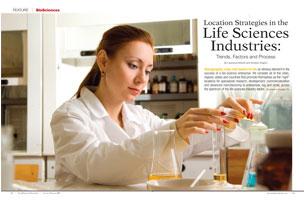
Geography may not seem to be an obvious element in the success of a bio-science enterprise. Yet consider all of the cities, regions, states and countries that promote themselves as the “right” locations for specialized research, development, commercialization and advanced manufacturing to enterprises, big and small, across the spectrum of the life sciences industry sector.
 Facility investment in the life sciences sector is one of the most sought after “prizes” in the business location arena. This headline could have been written fifteen years ago, five years ago or today. What differs now are several simultaneous and interrelated trends which are rapidly transforming the business of the life sciences, and are influencing where job creation and capital investments occur. These include:
Facility investment in the life sciences sector is one of the most sought after “prizes” in the business location arena. This headline could have been written fifteen years ago, five years ago or today. What differs now are several simultaneous and interrelated trends which are rapidly transforming the business of the life sciences, and are influencing where job creation and capital investments occur. These include:
The convergence of core technologies that spawn bio-sciences innovation.
Changes in the business operating models that manage the research/discovery to commercialization process.
The increasingly tightening interdependency and specialization of the health and patient care industry with the life sciences industry.
This article highlights the importance of workplace geography and the process of location selection in light of these core trends and how ‘place’ decisions apply across the life sciences.
Defining Life Sciences
It is challenging to categorize all of the industries and activities comprising life sciences given the complex and changing inter-relationships among many specialized sectors. Rather, it is useful to view the life sciences as a spectrum ranging from scientific research and development to commercialization and manufacturing to medicine and patient care then information management. Some of the key sectors include:
Biotechnology: The application of engineering and technology to life sciences - includes the use of biological processes, organisms or systems to produce products intended to improve human life quality. The sector is comprised of companies developing and commercializing new treatment therapies often focused at the genetic level.
Bio-informatics: The dry science of biotechnology. The application of information technology to the field of molecular biology. This involves the creation and advancement of databases, algorithms, computational and statistical techniques, and theory to solve problems arising from the management and analysis of biological data.
Medical devices: Production of bio-medical instruments for patient diagnostics, treatment and care as well as simulation equipment and training; these range from the simple (e.g., tongue depressors) to the exceptionally complex (e.g., bio-robotics).
Pharmaceuticals: Traditional “big pharma” companies which are emerging as key commercializers and integrators of biotech innovation.
Personalized medical management: A broad range of clinical activities, training and health care I/T in support of improved patient care ranging from personalized drug and treatment therapies to physician training and certification.
Electronic health records management: Digitizing medical records is said to have vast potential to save time, money and patient lives. It also is said to have the ability to positively impact drug discovery and clinical development through more efficient and rapid interface with medical information.
In addition to the core sectors mentioned above (within which is a very complex range of highly specialized industry niches) are other pillars of the broader health care and delivery sector:
Universities and Teaching Hospitals: the sources of fundamental research and discovery, start-up business support, entrepreneurial business incubators, etc.
Contract Research Organizations (CROs): a service organization that provides outsourced pharmaceutical research services to drug and medical device manufacturers.
Provider Networks: hospital and physician networks, the personalized front-line delivery points of health care.
Insurers, Regulators and the Payer-Payee Finance Infrastructure: which have a pivotal role and huge support infrastructure.
Venture Capital Firms: the fuel to seed promising investment.
Economic Development Organizations: Economic development has an increasingly important role enabling life sciences clusters via provision of a positive business climate, effective incentives, appropriate facilities and infrastructure, comprehensive workforce development programs and the fostering of a collaborative environment among science, business and academic partners.
In particular, the presence of noted universities and teaching hospitals and the specialized research occurring there, in combination with venture capital and a nurturing economic development environment are essential elements for a business location to thrive as a life sciences cluster. A handful of locations are fortunate in this regard, others are emerging and many other communities are competing for shares of this pie.
Life sciences industry location decisions vary by function
Cutting edge biological discovery, commercialization and manufacturing comprise the core of life sciences. However, other functions such as headquarters and customer servicing are also part of the equation. Each of these is driven by different location strategies.
 In general, site selection engagements for the life sciences industry fall between two distinct poles. At one end of the spectrum are cost-driven decisions; at the other end are performance-driven decisions. A cost-driven strategy is one that emphasizes reductions in operating expenses. A performance-driven location strategy is one where cost containment is secondary to overriding value enhancement factors related to innovation and the strategic viability of the enterprise.
In general, site selection engagements for the life sciences industry fall between two distinct poles. At one end of the spectrum are cost-driven decisions; at the other end are performance-driven decisions. A cost-driven strategy is one that emphasizes reductions in operating expenses. A performance-driven location strategy is one where cost containment is secondary to overriding value enhancement factors related to innovation and the strategic viability of the enterprise.
Much of the R&D, commercialization, financing and headquarters functions in life sciences companies are located on the basis of performance-driven factors. Communications and collaboration synergies to ensure creativity, leverage market trends and gain intelligence often keep these functions located together and geographically clustered with similar organizations. Such functions are typically located according to factors such as talent and skills availability (usually in conjunction with a superior quality of life to attract knowledge workers), presence of synergistic organizations, business and tax climate which supports innovation, and sites which have both the appropriate infrastructure for the particular activity and which project an image that communicates cutting edge discovery. Intellectual property protection is particularly important to those searches being managed globally.
The supporting business functions of the life sciences industry will tend to be sited according to cost factors and workforce availability. The emerging electronic health records management industry provides a good example of a cost-driven location strategy. In this example, business processing, electronic imaging and information technology requirements will drive the site selection search and many if not most of the geographic specifications for these requirements will be based to a large degree, on bottom line costs.
 Likewise, as life sciences companies evolve from start-up to mature organizations, the business imperatives increase proportionally, and these requirements are often cost-driven. Established, global biotech companies and the major pharmaceutical enterprises have large (in some cases, huge) enabling and supporting organizations beyond their core science, medicine and bioprocessing businesses. These include internal finance, human resources, training, marketing, regulatory, corporate governance and customer servicing. For companies with multiple businesses and geographic footprints, many of these functions tend to consolidate into regional and global shared corporate services operations. This trend is well established for human resources, payroll, customer servicing and corporate services (such as real estate) and is increasingly important for enterprise knowledge management. As these organizations become more complex and customer-centric (internal and external customers), siting strategies become more of a blend of performance-driven and cost-driven factors. It will be interesting to see how health care reform will influence shared services and knowledge center business models and their geographic implications.
Likewise, as life sciences companies evolve from start-up to mature organizations, the business imperatives increase proportionally, and these requirements are often cost-driven. Established, global biotech companies and the major pharmaceutical enterprises have large (in some cases, huge) enabling and supporting organizations beyond their core science, medicine and bioprocessing businesses. These include internal finance, human resources, training, marketing, regulatory, corporate governance and customer servicing. For companies with multiple businesses and geographic footprints, many of these functions tend to consolidate into regional and global shared corporate services operations. This trend is well established for human resources, payroll, customer servicing and corporate services (such as real estate) and is increasingly important for enterprise knowledge management. As these organizations become more complex and customer-centric (internal and external customers), siting strategies become more of a blend of performance-driven and cost-driven factors. It will be interesting to see how health care reform will influence shared services and knowledge center business models and their geographic implications.
Location strategies for life sciences manufacturing generally fall somewhere between a cost and performance focus, depending on the sophistication of the specific manufacturing process, intellectual property sensitivity, the capital invested in the operation, the required skills, infrastructure and need to be proximate to markets and other corporate functions.
Life sciences industry location decisions also vary by business maturity
The life sciences industry is driven by a high risk/high reward equation, often starting with the discoveries made by leading scientists, physicians and bioengineers at universities, teaching hospitals and start-up businesses. Angel and venture capital fuel the development of the most promising ventures. The very few that have efficacy and exhibit commercial potential may ultimately be acquired by established biotech and pharmaceutical players as a lower risk path to new therapies than internal research and discovery. These nascent industries require a specific recipe for success that combines best in class talent, collaborative networks and incubation. Incubation comprises academic and business partners, financial partners (seed capital) and facilities (laboratories, etc). The role of economic development is also important in fostering a business climate supportive of entrepreneurial activity, coordinating and supporting the collaborative partners, planning strategies for like-industry clustering and developing sites, infrastructure and incentives that will attract life sciences jobs and investment.
The life cycle is continuous from discovery/introduction to growth, maturity and eventual decline until new discoveries/innovative solutions and resultant services and products are introduced. And so the cycle continues. As the enterprise grows, this means managing a geographic and facility footprint that is flexible enough to support changing conditions. The stages of this cycle are illustrated below:
Stage One: Start-up. Siting priorities include business incubation and acceleration support, angel/venture capital sources, collaborative networks, intellectual property protection and quality of life.
Stage Two: Growth. Location decisions are most often driven by access to knowledge and talent pools, tax structures to minimize profit exposure, facilities infrastructure, market presence and intellectual property protection.
Stage Three: Maturity. As life science enterprises mature, cost and rationalization gain importance – managing the size of supporting internal services and the efficiency of multiple workplaces. Innovation often springs from acquisitions and mergers.
Stage Four: Decline. Companies in decline tend to be concerned about cost reduction, such as layoffs, divestiture of unprofitable or non-core businesses and capital asset monetization.
Important Trends and Challenges
To help provide perspective on geography and business location in the life sciences, here are some important trends and challenges to consider:
 Convergence of Related Industries: Seemingly disparate technologies are converging – information technology and biotechnology; health care and medical records management; micro-robotics and drug therapies. Convergence challenges the very definition of traditional industries, but provides the site seeker (and economic developer) new alignments of talent and industry clusters to tap into to achieve business needs (for example, convergence in nano-biotechnology and the telecommunications and information technology sectors).
Convergence of Related Industries: Seemingly disparate technologies are converging – information technology and biotechnology; health care and medical records management; micro-robotics and drug therapies. Convergence challenges the very definition of traditional industries, but provides the site seeker (and economic developer) new alignments of talent and industry clusters to tap into to achieve business needs (for example, convergence in nano-biotechnology and the telecommunications and information technology sectors).
Changing roles of traditional players: Fundamental discovery-commercialization pathways are changing in the life sciences industry. A good example is the shifting role of large corporate pharmaceutical companies as the engines of research and discovery to commercialization integrators of promising discoveries developed by more nimble, smaller biotech enterprises. And so the location strategies within pharmaceutical companies tend to shift away from siting large R&D centers and blockbuster drug development to acquiring patents and sourcing commercialization and regulatory talent, particularly in new geographic markets and for new products.
The changing business model of health care: Regardless of the status of current health care reform, the delivery of medical care is changing. From an economic development, corporate real estate and site selection perspective, this opens up new facility and job creation opportunities in emerging sectors such as electronic health records management, personalized medicine and medical simulation and training. From the perspective of life sciences companies, there is considerable pressure from insurers, consumers and providers to lower the cost of treatment therapies.
Cluster specificity and fragmentation: The life sciences industry is becoming extremely specialized as technology advances and morphs. It is increasingly difficult to align specific talent experienced in precise industry niches, which themselves continually evolve. The regulatory and facility planning and permitting implications of some new technologies, such as nanotechnology, are not fully charted.
Personal mobility constraints: The state of the housing market is having an unprecedented impact on personal mobility across all industries including life sciences. It’s hard to relocate if one has a house to sell at the origination end, and this has disrupted recruitment patterns to the detriment of locations with thin local supplies of specialized talent. Corporate relocation policies generally do not reimburse loss on home sale as this can be a very high additional cost of recruiting talent.
Guidelines for a successful location
Any industry as complex and dynamic as life sciences is bound to create challenges, and opportunities for site selectors. If we have been successful, this article will have given the reader a better understanding of the variables that can influence the location decision making of a broad cross-section of life sciences organizations. However, to be truly successful requires a thoughtful and comprehensive approach to the business location process. We close with a list of useful tips can help bring your next search to successful fruition.
Start with a vision. Determine what the critical factors that drive the business and the functions within are. Is the operation in question performance-driven or cost-driven? How critical is the project delivery timeframe? How specific are the facility and infrastructure requirements?
Prioritize objectives. Before thinking about specific locations, know what has to be achieved. How will critical talent be sourced and how much will that cost? How easy will it be to start up a new operation? Will future markets be the same as present markets? How much will it cost to move? These all affect the magnitude and search area of a location decision and the tier of locations that should be considered before beginning an exhaustive search.
Determine the investment costs. Understand the all-in expenses associated with the project. For example, if a fifteen percent reduction in payroll can be achieved in a new location, but your business case analysis indicates that it will require more than ten years of these savings to pay back the upfront costs, the strategy may need to be reworked. When conducting your analysis be sure to account for the impact of economic development incentives as these pricing tools can reduce both start up and operating costs and minimize risk.
Place all factors into perspective: Don’t be lured by a low cost environment if it can’t meet technology, workforce or other requirements.
Document the process: A logical, defensible decision-making methodology is the best way to insure that organizational consensus on the location is achieved.


